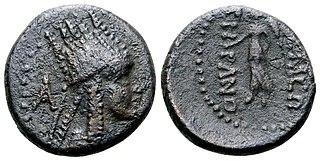
Alexander Helios was a Ptolemaic prince and son of Pharaoh Cleopatra VII of the Ptolemaic dynasty and Roman triumvir Mark Antony. Alexander's fraternal twin sister was Cleopatra Selene II. Cleopatra named her son after Alexander the Great. His second name in Ancient Greek means "Sun"; this was the counterpart of his twin sister's second name Selene (Σελήνη), meaning "Moon".

Lucius Cassius Dio, also known as Dio Cassius, was a Roman historian and senator of maternal Greek origin. He published 80 volumes of the history of ancient Rome, beginning with the arrival of Aeneas in Italy. The volumes documented the subsequent founding of Rome, the formation of the Republic, and the creation of the Empire up until 229 AD, during the reign of Severus Alexander. Written in Ancient Greek over 22 years, Dio's work covers approximately 1,000 years of history. Many of his 80 books have survived intact, or as fragments, providing modern scholars with a detailed perspective on Roman history.

Phraates IV was King of Kings of the Parthian Empire from 37 to 2 BC. He was the son and successor of Orodes II, and was given the throne after the death of his brother Pacorus I. Phraates IV soon murdered all his brothers, and also possibly his father. His actions alienated the Armenians and also some of his nobles, including the distinguished Monaeses, who fled to the Roman triumvir Mark Antony, but shortly returned and reconciled with Phraates IV.

Artavasdes II was king of Armenia from 55 BC to 34 BC. A member of the Artaxiad dynasty, he was the son and successor of Tigranes the Great, who ascended the throne of a still powerful and independent state. His mother was Cleopatra of Pontus, thus making his maternal grandfather the prominent Pontus king Mithridates VI Eupator. Like his father, Artavasdes continued using the title of King of Kings, as seen from his coins.

Artaxias II, also known as Artaxes II and Artashes was a prince of the Kingdom of Armenia, member of the Artaxiad dynasty and King of Armenia from 34 BC until 20 BC.
Polemon I Pythodoros was the Roman Client King of Cilicia, Pontus, Colchis and the Bosporan Kingdom. Polemon was the son and heir of Zenon and possibly Tryphaena. Zenon and Polemon adorned Laodicea with many dedicated offerings.
Erato was a queen of Armenia from the Artaxiad dynasty. She co-ruled as Roman client queen in 8–5 BC and 2 BC–AD 1 with Tigranes IV. After living in political exile for a number of years, she co-ruled as Roman client queen from 6 until 12 with Tigranes V, her distant paternal relative and possible second husband. She may be viewed as one of the last hereditary rulers of her nation.

Tigranes III was a prince of the Kingdom of Armenia and member of the Artaxiad dynasty who served as a Roman client king of Armenia.
Vipsania Polla was an ancient Roman woman of the late Republic, she was the sister of emperor Augustus' right hand man Marcus Vipsanius Agrippa. She is best known today for the construction of the Porticus Vipsania.

Tigranes IV was a prince of the Kingdom of Armenia and member of the Artaxiad dynasty who served as a Roman client king of Armenia from 8 BC until 5 BC and 2 BC until 1 AD.

Artavasdes IV of Armenia; also known as Artavasdes II of Atropatene; Artavasdes II of Media Atropatene and Armenia Major; Artavasdes II, and Artavasdes was an Iranian prince who served as King of Media Atropatene. During his reign of Media Atropatene, Artavasdes also served as a Roman Client King of Armenia Major.

Artavasdes I of Media Atropatene, also known as Artavasdes I of Atropatene and Artabazus, was a prince who served as a king of Media Atropatene. Artavasdes I was an enemy of King Artavasdes II of Armenia and his son Artaxias II. He was a contemporary with the Ptolemaic Greek Queen Cleopatra VII and Roman Triumvir Mark Antony, as Artavasdes I was mentioned in their diplomatic affairs.
Gaius Fufius Geminus was an imperial Roman senator who was appointed suffect consul for the period September-October 2 BC, as the colleague of Lucius Caninius Gallus.
Ariobarzanes I of Media Atropatene, also known as Ariobarzanes I of Media, Ariobarzanes of Atropatene, Ariobarzanes I and Ariobarzanes was king of Media Atropatene.
Ariobarzanes II of Atropatene also known as Ariobarzanes of Media; Ariobarzanes of Armenia; Ariobarzanes II; Ariobarzanes II of Media Atropatene and Ariobarzanes was king of Media Atropatene who ruled sometime from 28 BC to 20 BC until 4 and was appointed by the Roman emperor Augustus to serve as a Roman client king of Armenia from 2 AD until 4.
Iotapa was a princess of Media Atropatene, daughter of King Artavasdes I of Media Atropatene. She was Queen consort of King Mithridates III of Commagene.
The aerarium militare was the military treasury of Imperial Rome. It was instituted by Augustus, the first Roman emperor, as a "permanent revenue source" for pensions (praemia) for veterans of the Imperial Roman army. The treasury derived its funding from new taxes, an inheritance tax and a sales tax, and regularized the ad hoc provisions for veterans that under the Republic often had involved socially disruptive confiscation of property.
There is an incomplete list of governors of Azerbaijan, a region in northwestern Iran.
Publius Plautius Rufus flourished during the first century, during the Principate of Augustus.

Artavasdes III was a king of the Kingdom of Armenia who ruled from 5 to 2 BC. He may have been a son of the Artavasdes II of Armenia, thus a brother of Artaxias II and Tigranes III and an uncle of Tigranes IV. Augustus had commanded the enthronement of Artavasdes III as Armenian king, or soon after, in the effort to supplant Tigranes IV and Erato. Artavasdes was forcibly driven out, presumably by supporters of Tigranes IV backed by Parthia.










